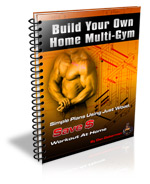
Click Here for Free Bodybuilding and Fitness Magazine Subscription
Build A Weight Bench

Click Here To Build Your Own Home Gym
How To Build Your Own Homemade Weight Lifting Bench
Many people enjoy a good work out. The problem is that they are forced to either buy expensive equipment, or end up paying membership fees to a gym they have to take the time to travel to.
For more enterprising people there is the ability to craft some of their own workout equipment. One of the simplest items to craft is the time tested weight bench.
A basic weightlifting bench will require the following items: A measuring tape, a minimum of two five and a half inch by one and a half inch boards, seven two inch by four inch boards, two steel rods with a u or v shaped peice of metal on one end, a hand saw, and four screw in clamps.
Screw in padding for the bench will make it more comfortable. The final items required are wood screws to put this bad boy together. Thirty should do it, but feel free to have more on hand.
First, measure your body length to determine the best fit. Do this measurement for total length as well as for the length from the top of your head to the base of your knees. Give at least two inches beyond this for comfort and sliding issues.
Take two of your two by four's and use them as a brace so that you can cut your boards to the appropriate lengths for your height measurements. Use the two wider boards as the surface of the bench and screw the bracing to the bottom side. You will want to place three boards for bracing. One will be at the bottom. Another at the top. There will be a final one in the middle.
Place the top and bottom boards roughly two inches from ends so that you can screw the other four boards to the bench for legs. With this complete, make certain you measured properly by laying on the bench and experimentally lifting your arms.
If this feels relatively comfortable you're probably good to go. If you feel the bench is to high or low, then correct that with your hand saw or some support blocks.
All your need to do now is attach the padding for extra comfort and install your steel rods to act as a weight holder for bench pressing. The rods are clamped to the legs at about three inches off the ground and once again another three to six inches higher, depending on the length of your bench's legs.
At any rate, make certain the rods are sturdy and straight. If you intend to use this to be an outside weight bench, you may attempt to pound the rods into the ground before clamping, for extra stability.
Make certain that when fully extended your arms are a few inches above the top of where the bar will rest. Once all your checks for stability are complete, you are done.
No Welding, Easy Detailed Plans. Construction Is Simple And Quick,
No Special Skills Required, Can Be Built For A Fraction Of The Cost
Of Most Commercial Home Gyms And Does Much More!

Click Here To Build Your Own Home Gym
Build A Weight Bench, How To Build A Weight Lifting Bench

